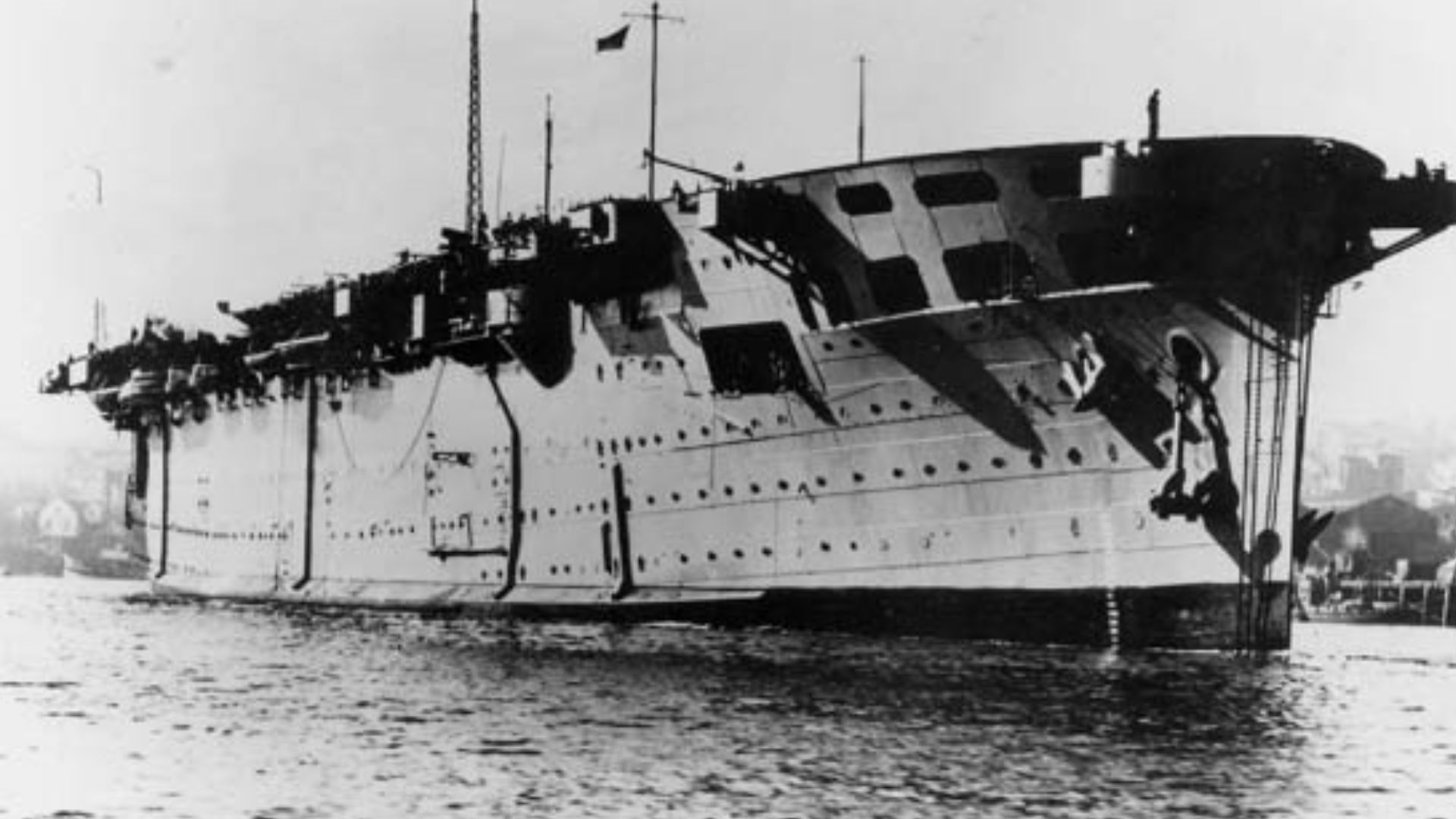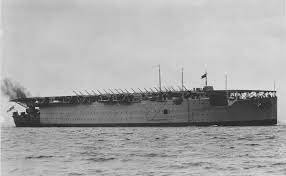
The maritime history of nations is often marked by iconic vessels that have left an indelible mark on naval warfare and strategy. Among these, the HMS Argus I49stands out as a pioneer in naval aviation.
HMS Argus, a British Royal Navy aircraft carrier, was built quickly during World War 1 to deploy torpedo bombers. The William Bearmore shipyard lay down the completed hull of the Italian-bound oceanliner "Conte Rosso" in 1914. Before the war, Beardmore tried to offer the Royal Navy a "through-deck" flat-top aircraft carrier, but it was rejected.
From its inception to its crucial role in shaping the future of naval air power, the Argus I49 has etched its place in the annals of naval history.
HMS Argus I49 - Background
From 1918 to 1944, the HMS Argus operated as an aircraft carrier for the British Royal Navy. When World War One broke out, she was still a passenger liner being built into what would become the world's first aircraft carrier, complete with a runway long enough for wheeled planes to land. After being put into service, the ship spent years contributing to the creation of the best possible blueprint for future aircraft carriers.
Argus also conducted analyses on fleet tactics, general processes required to fly several aircraft simultaneously, and different forms of arresting gear. In the middle of the twentieth century, the ship underwent alterations to make her less top-heavy. In the 1920s, she was sent for a short time to the China Station before being put in reserve due to financial constraints.
Argus Recommissioned
Until June of 1940, Argus operated as a training ship for deck landing practice after being recommissioned and largely modernized just before the Second World War. For the next two years, she spent most of her time transporting combatants from the West Mediterranean to Malta. Her first journey there was the following month.
Aircraft were also sent to the Russian city of Murmansk, the Ghanaian port of Takoradi, and the Icelandic capital of Reykjavk. The Royal Navy desperately needed aircraft carriers by 1942, but Argus was too slow and unprepared for combat to be used. She took part in Operation Harpoon in June, providing aerial protection for the Malta-bound convoy.
The ship was slightly damaged by a bomb in November while providing air support for Operation Torch, the invasion of French North Africa. Once Argus had been repaired and returned to the UK, it was put back into service until late September 1944 as a deck landing practice vessel. She was converted into a lodging ship in December and put up for auction in the middle of 1946. After being sold in late 1946, the ship was eventually demolished in 1947.
Design And Construction Of Hms Argus
The Argus was the first ship of its kind. The Argus started as an Italian liner and was built between 1914 and 1916; the British Royal Navy bought it in 1916 and converted it, finishing the job in September 1918.
The Argus's flight deck was roughly 560 feet (170.7 meters) in length, and its hangar could house up to 20 planes. There were six four-inch cannons on board, and its top speed was 20.2 knots. The Argus was utilized for trials and training in addition to its primary function as an operational carrier.
British Navy First Aircraft
During World War I, the British Navy produced the HMS Argus, the first actual carrier with an unobstructed flight deck based on a modified merchant ship hull. Unfortunately, the war ended before the Argus could be placed into service, but the United States Navy and the Japanese Navy shortly followed the British example.
In March of 1922, the USS Langley, a renamed converted collier, became the first U.S. carrier. The Hosyo, a Japanese carrier that initially saw service in December 1922, was the first to be explicitly built as a carrier.
HMS Argus Commissioning And Early Service
After commissioning too late to combat in WWI, Argus was given longitudinal arresting gear from Furious to conduct deck-landing tests. The ship's initial landings were made by two Grand Fleet Turnhouse airfield Sopwith Ship Strutters on September 24, 1918.
A canvas and wood dummy island with a smoke box to simulate funnel gasses was created onboard the ship the same month to test the effects of an island superstructure on flying operations. By the 19th, Ship Strutters and Sopwith Pups had landed 36 times. Argus was refitted with better arresting gear from December 23 to March 21, 1919.
The arresting gear cables were lifted off the flight deck to connect the aircraft's undercarriage hooks, making it unavailable for other reasons. The after-lift was lowered by 9 inches (229 mm) and leveled with the flight deck to accommodate the aircraft. Testing began in April, and the lift was expanded by October.
Argus began its Spring Cruise with the Atlantic Fleet in January 1920 with sixteen aircraft, comprising eight Ship Strutters, four Sopwith Camel fighters, two Airco DH.9A bombers, and two Fairey floatplanes. Three aircraft were blown over the ship during the journey, indicating that landing directly on the arresting gear is safer.
HMS Argus' Involvement In Second World War
After recommissioning, Argus trained pilots in deck-landing. She was doing this in the Gulf of Lion when WWII started. By April 1940, the ship mounted two QF Mk V 4-inch anti-aircraft guns on her quarterdeck and three triple Vickers - 50 machine gun mounts - one on each side of her hull and one on the quarterdeck centerline. In mid-June, Argus, Hood, and six destroyers escorted Australian and New Zealand soldiers on Convoy US-3 to the UK.
A week later, she transported 701 Squadron Supermarine Walrus amphibians to Reykjavík, Iceland. In late July, Argus loaded 12 Hawker Hurricanes and two Blackburn Skua planes of 418 Flight RAF for transport to Malta as part of Operation Hurry.
Escorted by Ark Royal, three battleships, two cruisers, and 10 destroyers, the ship flew them off west of Sicily on 2 August 1940 without difficulty, however, two Hurricanes crashed on landing.
With the battleship Valiant and two destroyers, she returned to Liverpool to load 30 wingless Hurricanes. Argus departed on 22 August and unloaded her aircraft at Takoradi on the Gold Coast on 5 September. After a short refurbishment, the ship returned 701 Squadron to the UK in late October.
Argus Operation White
Operation White saw Argus sail from Liverpool with 12 Hurricanes and 2 Skuas to Malta on November 11. She met Force H four days later and launched the plane on the morning of 17 November. Eight Hurricanes ran out of fuel owing to headwinds, while one Skua crashed on Sicily when Italian artillery damaged aircraft.
The ship loaded six Fairey Swordfish torpedo bombers from 821X Squadron for Gibraltar and two from 825 Squadron for self-defense in mid-December. The carrier met Furious and Convoy WS-5A before the German cruiser Admiral Hipper spotted them on 25 December. Hipper caused minor damage before the escorts drove her away.
The German ship could not be attacked by air because the Swordfish were in Argus with bombs they could not carry, and Furious had torpedoes. Space was opened for Argus' Swordfish to load torpedoes when Furious's Skuas flew off to find Hipper, but limited visibility prevented them from finding him. To Gibraltar, Argus supplied 821X Squadron and returned to the UK on 14 January 1941.
Argus Ferried Transported Gibraltar
On March 29, the carrier transported 12 Hurricane IIs and three Skuas to Gibraltar, where they were loaded aboard Ark Royal and flown to Malta a few days later. After returning to the UK on 11 April, she carried six replacement Swordfish and six 812 Squadron Swordfish for self-defense. Argus left for Gibraltar on April 14 to transfer replacements to Ark Royal after a quick refurbishment.
She arrived on 24 April and started a two-week overhaul once the planes were moved. Back in the UK, the ship loaded more Hurricanes for Gibraltar. Three 800X Squadron Fulmars protected the ship from Focke-Wulf Fw 200 Condors patrolling the Bay of Biscay and Eastern Atlantic. On May 31, the carrier unloaded 800X Squadron and all its aircraft. Refitting commenced upon her return to the UK.
Argus Ferried Hurricanes To Russia
From late August to early September, Argus ferried 24 No. 151 Wing RAF Hurricanes to Murmansk, Russia. On 30 September, she transported 12 828 Squadron Fairey Albacore torpedo bombers to Gibraltar for transfer to Malta. She was to return to England with 804 Squadron fighters, but this was canceled.
Eagle returned to the UK on 20 October with the ship carrying damaged planes. Argus loaded additional Hurricanes for Gibraltar and self-defended with two Swordfish from the 818 Squadron and two Sea Hurricanes from the 804X Squadron.
Some Hurricanes were moved to Ark Royal when the ship arrived on November 8. Operation Perpetual two days later saw the two carriers cruise west of Sicily and launch 37 Hurricanes, losing three planes. Argus was the only carrier available to support Force H when Ark Royal was torpedoed and lost on the way to Gibraltar.
The Historical Significance Of HMS Argus I49
Unraveling the historical significance of HMS Argus unveils a narrative of innovation, adaptability, and a paradigm shift in naval warfare. This aircraft carrier, with its distinctive table design featuring two rows and columns, stands as a testament to a pivotal moment in history that redefined the role of air power at sea.
Revolutionizing Naval Aviation - A Catalyst For Change
HMS Argus emerged during a critical juncture in naval history, and its historical significance lies in its role as a catalyst for change in naval aviation. The carrier was not just a vessel; it represented a paradigm shift from traditional naval strategies, demonstrating the potential of integrating air power into maritime operations.
The innovative table design, characterized by dual rows and columns, played a central role in this revolution. It showcased the adaptability of naval forces to embrace new technologies, laying the foundation for the future dominance of aircraft carriers in naval fleets worldwide.
World War II And Beyond - The Argus Legacy Lives On
The historical significance of HMS Argus extends beyond its initial years of service. While the carrier did not participate in major battles during World War II, its influence permeated naval strategies and paved the way for the development of dedicated aircraft carriers. The lessons learned from the Argus's operational experiences became integral in shaping the future of naval aviation.
Post-World War II, the legacy of HMS Argus continued to reverberate. The carrier's historical significance was not confined to a specific era but lived on in the design principles and strategic doctrines that defined modern naval forces. The Argus became a symbol of innovation and adaptability, leaving an indelible mark on the historical landscape of naval warfare.
A Pioneer's Legacy - The Global Impact Of HMS Argus
HMS Argus's historical significance transcends national borders, influencing the trajectory of naval aviation on a global scale. The carrier's innovative table design, characterized by dual rows and columns, became a blueprint for future aircraft carriers across different naval fleets.
Navies around the world took note of the Argus's pioneering role and incorporated its lessons into their own strategies. The carrier's impact reached far beyond its operational years, contributing to the evolution of naval doctrines and the recognition of air power as a decisive factor in maritime conflicts.
Hms Argus I49 - FAQs
When Was HMS Argus I49 Decommissioned?
HMS Argus I49 was decommissioned in 1944.
What Innovative Feature Sets HMS Argus I49 Apart From Traditional Naval Vessels?
HMS Argus I49 featured a flat flight deck and a hangar below, pioneering the concept of aircraft carriers.
How Did The Introduction Of The Table On HMS Argus I49 Influence Naval Aviation Safety?
The table on HMS Argus I49, equipped with arresting gear, significantly enhanced safety during aircraft landings by providing a controlled deceleration process.
In What Conflict Did HMS Argus I49 Play A Key Role In Convoy Protection?
HMS Argus I49 played a crucial role in convoy protection during World War II.
What Was One Of The Key Technological Advancements Introduced By HMS Argus I49?
HMS Argus I49 introduced the use of steam catapults for aircraft launch, a technology that became standard in modern aircraft carriers.
Conclusion
HMS Argus I49 emerged as a trailblazer in naval aviation, leaving an enduring legacy defined by technological innovation and strategic adaptability. From its groundbreaking table design to its crucial role in shaping modern carrier operations, HMS Argus I49 stands as a symbol of naval prowess.
The carrier's contributions, marked by the introduction of steam catapults and arresting gear, continue to resonate in contemporary naval doctrines. The historical significance of HMS Argus I49 is etched in the annals of naval history, forever influencing the trajectory of naval aviation worldwide.



